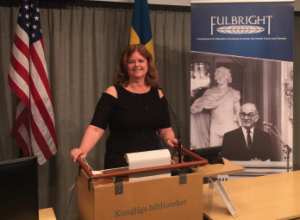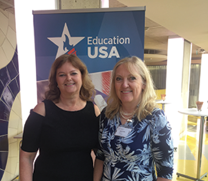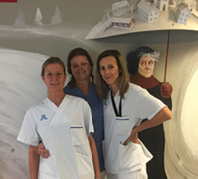
Dr. Maura Iversen was honored in a recognition ceremony at the Kunglia Biblioteket (the National Library of Sweden).
futuristman / shutterstock.com
A stroll through downtown Stockholm presents a quintessential picture of an active community, with most people biking or walking as their preferred mode of travel. Yet children in Sweden who live with juvenile idiopathic arthritis (JIA)—currently estimated at around 64 of every 100,000—don’t always engage in this active lifestyle.1 Maura Daly Iversen, PT, DPT, SD, MPH, FNAP, FAPTA, wants to know why.
Through a 2016–17 Fulbright Scholarship (the flagship international educational exchange program) she was awarded for research, Dr. Iversen is working in Sweden to investigate this issue. She is also engaged in several other studies in Sweden, including a study designed to determine how videos of patients can be used to more accurately assess physical function. Specifically, she examines how physicians and physical therapists can identify the presence of osteoarthritis (OA) through visual examination of movement patterns among patients with OA and healthy individuals.
As associate dean of clinical education, rehabilitation sciences and new initiatives in the Bouvé College of Health Sciences and professor in the department of physical therapy, Movement and Rehabilitation Sciences at Northeastern University in Boston, Dr. Iversen has spent the past decade investigating how activity interventions and outcome measures can improve disease management and overall health and well-being for adults living with rheumatic conditions. Her specific research has addressed such topics as validity and comprehensibility of current pediatric physical activity scales, perceptions of physical activity engagement among adults with rheumatoid arthritis (RA), comparative effectiveness of tai chi vs. physical therapy for knee osteoarthritis, how virtual reality games may improve mobility skills and balance measurements in community-dwelling older adults, and correlations of physical activity participation over three years in adults with RA.2-6

Dr. Iversen
Her goal with this work has been to help improve patient adherence to prescribed treatments, including physical therapy regimens and home activity, to achieve optimal health and mobility.
“Understanding how to help children with JIA optimize their physical activity has been the missing piece in my research,” she says.
Giving Pediatric Patients a Voice
Dr. Iversen believes that a focus on physical activity in Sweden can sometimes take a back seat to medication regimens and other attempts to reduce disease activity similar to the focus of children and adolescents in the U.S. who live with JIA. Dialing in the right approach to physical activity is an equally important aspect of treating JIA to reduce the risk for cardiovascular complications down the road. “It can also make a difference in helping these children gain physical confidence as they grow up with the disease,” Dr. Iversen stresses.

Dr. Maura Iversen with the Swedish Fulbright representative, Monica Dahlén.
She understands this as both a scholar and a parent, because her daughter Christina was diagnosed with JIA at age 4.
“Children with JIA are often treated differently,” Dr. Iversen notes. “They may be kept from activity by adults who fear injury, and they may be fearful themselves to become too active and risk aggravating painful inflammation.”
In the clinical care setting, Dr. Iversen suspects two important barriers may prevent proper assessment of physical activity, which ultimately will impact the design of physical activity interventions:
- Physical activity questionnaires don’t fully ascertain physical activity measures in children, and
- Fitness trackers are not capturing the full picture of a pediatric patient’s daily activity due to unique limitations of movement capture or restrictions on use (e.g., cannot be worn in water or cannot capture cycling).
Given the prevalence of JIA in Sweden, as well as a robust national registry and active patient organization for patients with JIA, Dr. Iversen has found Sweden to be an ideal location for a study that includes good baseline data, involved patients and a community with physical activity as a cultural norm.
Testing a Pediatric Activity Questionnaire in Sweden
Dr. Iversen is leading a phased study working with Swedish parents and their children living with JIA to test a unique pediatric physical activity questionnaire she designed. Through cognitive interviews with children taking the questionnaire, Dr. Iversen is investigating how a physical activity questionnaire designed specifically for pediatric and adolescent patients with JIA can more accurately collect patient information.
“Children with JIA are often asked about physical activity based on questionnaires designed for adults. Too often, these questionnaires don’t ask questions in the right way for a child to connect with,” Dr. Iversen explains. “Children are very literal, and questions need to address this to secure an accurate answer.”
She also says that when a child answers a two-part question, they are most likely to only answer the first part, which can also skew the accuracy of their response.
Data from these cognitive interviews will then be used to test the comprehensibility and validity of the questionnaire for application on a tablet. Her goal with this electronic format for the questionnaire is to provide a more streamlined method to collect consistent annual data from pediatric patients and follow their longitudinal physical activity.
Dr. Iversen hopes to integrate this electronic, evidence-based pediatric physical activity questionnaire through the Swedish JIA patient network to a broader population of Swedish patients with JIA. She also plans to compare these data on physical activity among Swedish children with JIA to children living with JIA in the U.S. to understand how cultural norms of physical activity may translate to children with JIA.
“There aren’t many comparative studies of children with JIA across different countries, but if you look at national data for physical activity of children in general, Scandinavian children tend to have higher activity compared with children in the United States,” Dr. Iversen notes.
This comparative study will contribute to Dr. Iversen’s long-range research on outcome measures to better quantify the intensity of physical activity, measured using questionnaires and fitness trackers. She says her ultimate goal with all of this research is to “ensure children with JIA are as physically fit as possible within the constraints of their disease to reduce the risk of physical complications long term.”
Making a Cultural Connection

Dr. Maura Iversen and colleagues at the Astrid Lindgren Children’s Hospital in Stockholm.
A primary goal in fulfilling a Fulbright Scholarship is to learn from the unique cultural and academic aspects of a country outside of the U.S., and Sweden is providing Dr. Iversen with many opportunities to fulfill this goal.
Through her work with research colleagues in Sweden, Dr. Iversen has experienced cultural events, such as the Midsummer Festival, and has had the opportunity to meet with other physical therapists and rheumatology researchers to think about spinout studies on different types of interventions to measure and promote physical activity.
She also has observed Swedes living and moving in their communities, noting, “the level of physical activity in general is much higher than you would observe in New England.” She continues to find Swedish patients and their parents very involved and willing participants in research.
“Where there are definite cultural differences on physical activity between Sweden and the United States, there are also similarities for practitioners and patients, including a focus on linking research to practice,” Dr. Iversen acknowledges. “I see in Sweden how having a patient organization intrinsically linked to research data and implementation can support more timely application of this research to improve patient care.”
As she thinks about applying what she has learned through research and cultural immersion in Sweden with her patients and the rheumatology community in Boston and the U.S., Dr. Iversen sees a clear path. This path includes asking children with JIA more direct questions. It also includes finding new ways to quantify and measure intensity of physical exercise to improve the lives of all patients with rheumatic conditions.
Her special focus is for the youngest patients living with JIA, who—like her daughter—need the courage and skills to exercise with confidence as they live with an “old person’s disease,” so they have every opportunity to build their best life.
Carina Stanton is a freelance science journalist based in Denver.
References
- Gäre BA, Fasth A. Epidemiology of juvenile chronic arthritis in southwestern Sweden: A 5-year prospective population study. Pediatrics. 1992 Dec;90(6):950.
- Iversen MD, von Heideken J, Farmer E, et al. Validity and comprehensibility of pediatric physical activity scales for children with sports injuries. J Pediatr Orthop. 2016 Apr–May;36(3):278–283.
- Iversen MD, Frits M, Cui J, et al. Perceptions of physical activity engagement among adults with rheumatoid arthritis and rheumatologists: A qualitative study. Int J Clin Rheum. 2015;10(2):67–77.
- Wang CC, Schmid CH, Iversen MD, et al. Comparative effectiveness of tai chi versus physical therapy for knee osteoarthritis: A randomized trial. Ann Intern Med. 2016;165(2):77–86. doi: 10.7326/M15-2143.
- Carregaro R, Iversen MD, Cardoso J, et al. Do virtual reality games improve mobility skills and balance measurements in community-dwelling older adults? Systematic review and meta-analysis. Clin Rehabil. 2017 Feb 1.
- Iversen MD, von Heideken J, Frits M, et al. Physical activity and correlates of physical activity participation over three years in adults with rheumatoid arthritis. Arthritis Care Res. 2016 Nov 18. doi:10.1002/acr.23156.
Additional Resources
Dr. Iversen’s daughter Christina shared her personal experience with JIA in a 2014 article in The Rheumatologist, “Growing Up with Juvenile Arthritis” (April; Vol. 8, No. 4).

